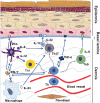Skin immunity and its dysregulation in psoriasis
- PMID: 31416396
- PMCID: PMC6773242
- DOI: 10.1080/15384101.2019.1653099
Skin immunity and its dysregulation in psoriasis
Abstract
The skin is a peripheral lymphoid organ, being the first immunological defense against infections as the initial interface between the organism and the external background. The maintenance of the skin immune homeostasis depends on a finely equilibrium of well-regulated relations between different cells and exogenous pathogens. Inflammatory skin diseases are directly linked to the dysregulation of this equilibrium. The present review discusses the role of the immune system, of T cells, in the etiopathogenesis of psoriasis, illustrating a potential rationale for innovative therapeutic intervention.
Keywords: Psoriasis; biologic therapies; cytokines; immunity; lymphocytes.
Figures



References
Publication types
MeSH terms
Substances
LinkOut - more resources
Full Text Sources
Medical
